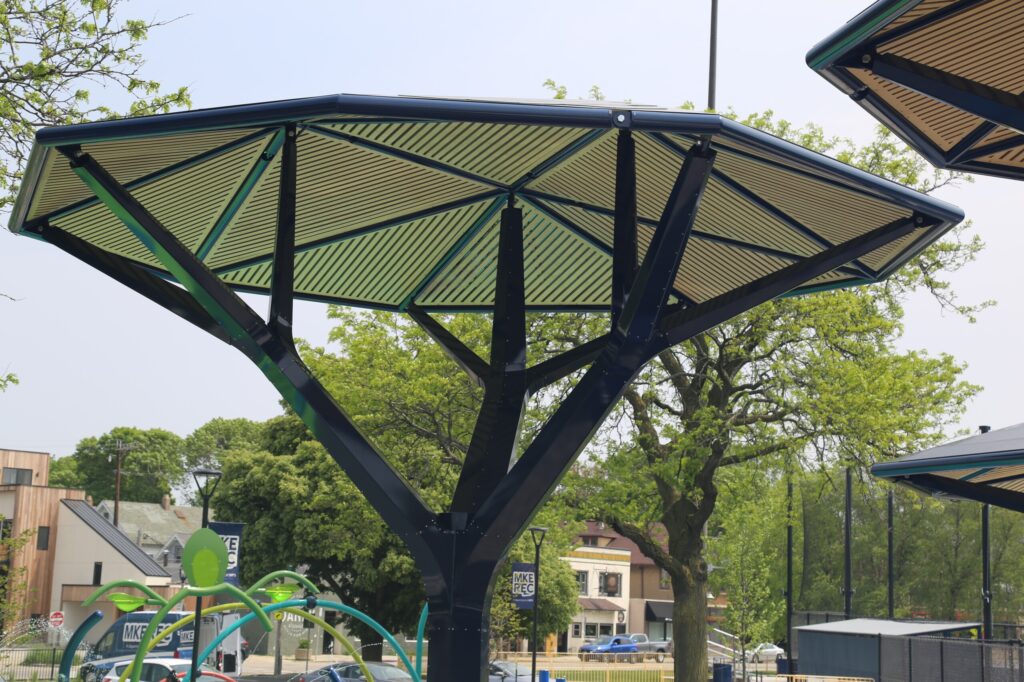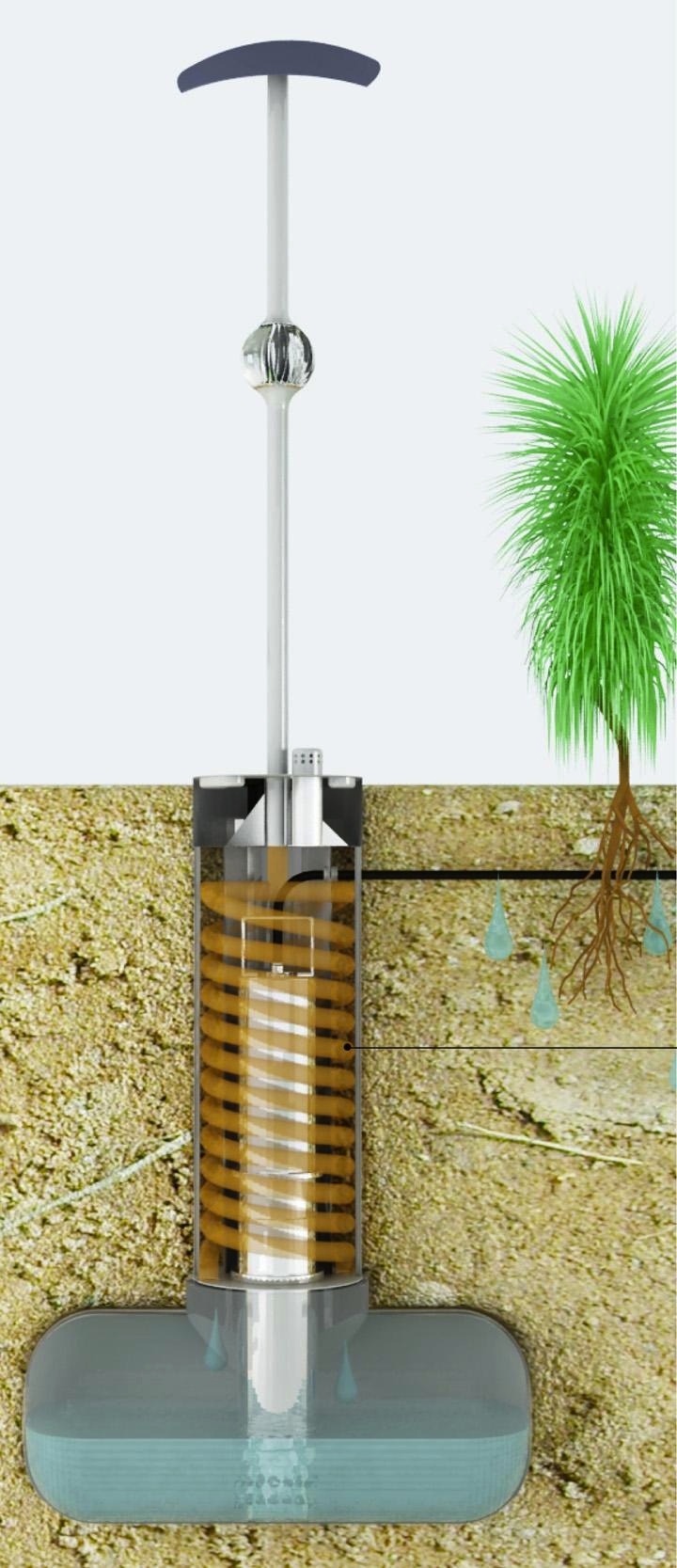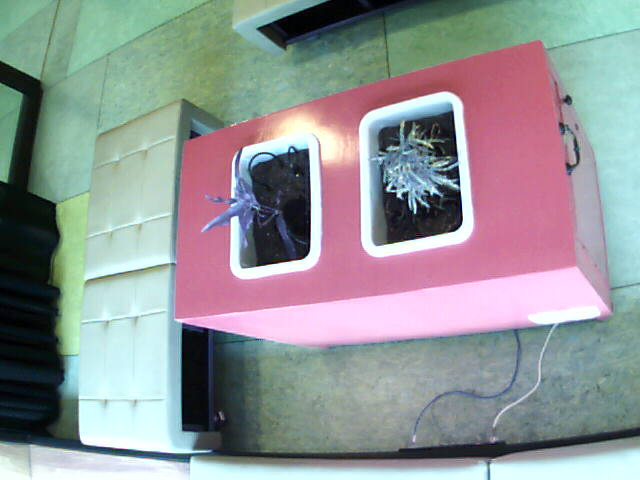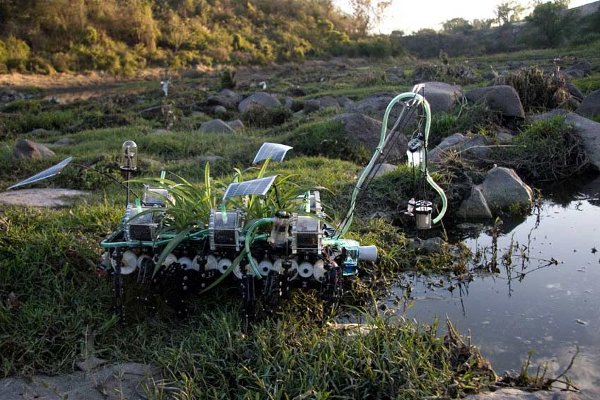
Eau Claire, Wisconsin’s SolarForma has created these solar panel supporting tree structures they call E-Cacia. Each tree produces 3.5 kW of electricity, while simultaneously providing 440 square feet of usable shade.

Eau Claire, Wisconsin’s SolarForma has created these solar panel supporting tree structures they call E-Cacia. Each tree produces 3.5 kW of electricity, while simultaneously providing 440 square feet of usable shade.

Designed by Huy Bui, Jon Schramm of HB Collaborative and Carlo Gómez de Llarena have designed a set of interlocking cedar boxes to create an automated terrarium. Called Plant-In City, they are currently running a Kickstarter Campaign to gather funding to finish prototypes and to ramp up production.
The system consists of three different cedar frames. The main frame is the “light frame”, and features LEDs mounted along the top rectangle. A “soil” frame a simple box that contains dirt along with sensors to monitor light, humidity and moisture. The last frame is the “water frame” and it is made up of a water tank along with tubing and a solenoid valve to control water flow. The sensors, lights, and valves are connected to an arduino that wirelessly connects to the Internet. Through either the Plant-It City website or mobile app, owners can monitor and control their frames via cosm.com‘s API. The sensors not only alert the owner to changes in the terrarium, but also are used to drive an audio and visual effects for in-person visitors of the system.
Electronic Origami Flapping Crane w/ tutorial from Jie Qi on Vimeo.
Jie Qi at the High-Low Tech lab at MIT’s Media Lab, posted a HOWTO on nitinol and origami. In the HOWTO she mentions that you can’t solder the nitinol directly, and so you’ll have to have create a soldering pad for it. (She used a craft crimp bead.) Another tip she gives is the need to preheat the nitinol by running a 9 volt charge through it for five seconds. When the wire relaxes, it will become be longer than it was originally, and so you’ll need to retention the wire. Last of all, she warns against keeping the wire energized too long, lest your “burn out” the nitinol. In another project, Qi mentions she used 0.006 inch flexinol for the origami, but used 0.01 inch for the more rapid vine/snake project.
I have had a fairly long interest in synthetic plants and was thinking if nitinol could be used to in a heliostat or some sort of dinural deployable structure, but I never knew the reaction time of nitinol. Seeing it used understanding what voltages are required was helpful. (Poking around just now, I also ended up finding a handy nitinol wire width-voltage-time-force table.) While I doubt that I will ever actually build whatever vague idea idea I have for synthetic plant, I’ve come to conclusion that nitinol perhaps isn’t the best choice of materials if you want it to hold position for any considerable length of time (or at least not without some sort of mechanical latching).

The winner of this year’s James Dyson Award, Edward Linnacre’s Airdrop is a device that extracts water from air for use as in irrigation. If this sounds, like a Tatooine moisture farm, it should. However, unlike Uncle Owen’s GX-8 water vaporator, the Airdrop doesn’t use refrigerant, but rather the temperature differential from air to soil.
The Airdrop consists of a small reservoir buried about two meters in soil. Rising out of the tank and up to the surface is a cylinder containing a copper coil filled with copper ball bearings used in home distilleries. The copper tubing continues up to a turbine like those used on attic vents, but with the vanes turned around so that air is driven into the tubing instead of out of it. Also in cylinder is a submersible pump that transfers water from the tank to a drip irrigation line. The pump is controlled by an embedded microcontroller and solar powered. In times of little wind, the turbine can be powered by an electric motor.

d&@le Concepts concepts (nomme de art for Alessandro De Ambrogio and Carlos Basanta) have created the GUL Two, a solar powered LED plant that lights up at night. Currently installed at in the Elemental Gardens at Pacific National Exhibition in Vancouver.

Bashkim Isai has hooked up a plant so that it gets its nourishment from interacting a social networks. Named Meet Eater, the plant receives a dose of water every time someone performs a social gesture about it on Facebook. After 91 days, it currently has 8140 fans.
Do we have something to replace Internet vending machines? No. Nothing will replace Internet vending machines.
Thanks Max!
MIT has published a paper entitled Programmable Matter by Folding (full article) that describes paper that can fold itself into a variety of shapes. The paper is covered by is divided into triangular sections that are joined by a network of thin nitinol actuators that contract under voltage. At the center of each section is a magnet that is used to retain the paper’s shape.
While I’m sure MIT had bigger plans for this tech (Well if it was the Media Lab, perhaps not.), I immediately thought that this was the perfect thing for synthetic plants. I’ve been thinking about how nitinol wires, or at least something like them, could deform a paper but thought that the being able to compresses only about 4% was a problem. When I first saw this video, I thought they were using something else besides nitinol, but they’re not. The trick they they used to get 180 degree bending is folding and annealing the 100μm foil so that the nitinol will remember the folded shape. Once it cooled, the foil is manually flattened, and then reheating the foil with electrical current will cause it return to the folded shape.
Guess it’s time to get some nitinol sheets.

Ah, Vivien Muller! Is there anything you make that I won’t post? Above is Electree, his latest creation. It’s a purple Photonsynthese, and is being presented at the Palais de Tokyo in Paris on the occasion of the 1.618 sustainable luxury fair.
Limited to 1000 editions. Price €4950 (~ $6354).
I like it. I like the blue of Photonsynthese more though. Don’t like the price at all. More disturbingly, it’s just too derivative of his earlier work. It seems like the big change in this one is that it uses rare earth magnets instead of headphone jacks to mount the solar cells. Really, really don’t like that price.

Now this is nifty.
We Make Money, Not Art interviews, Gilberto Esparza about his Plantas Nómadas (Nomadic Plants), an autonomous walking robot that is powered by a combination of solar cells and a microbial fuel cell. When the fuel cell output drops beneath some threshold, the bot seeks out a water source, extends a proboscis and refills the fuel cell. Additional water is used nourish a colony of on board plants.
Gilberto’s earlier work is equally interesting. Parasitos Urbanos (Urban Parasites) (flashless site) was a series of robots inductively powered from electrical transmission lines that would move through the urban environment mimicking sounds they encounter.

Spanish art collective, Luzinterruptus latest creation, JardÃn para un Futuro, No Muy Lejano (Garden for a Not Too Distant Future), is 110 clear plastic containers, each containing a few leaves and branches, along with a green LED.
The artist statement says that installation was a humorous statement about the lack of green space in modern cities; but given the frequency of their installations, I think that’s more just talk than anything.
Luzinterruptus weekly installations are a bit repetitive. For instance, “JardÃn” is reminiscent of their December work, Naturaleza Contra Cristal (Nature Against Glass), where they placed green LEDs and tree clippings on the Madrid Metro elevators stations. Parallels to Graffiti Research Lab‘s LED Throwies and Goggin and Keehn’s The Language of Birds could also be made.
Yes, it’s repetitive. Yes, other people are doing the same thing, perhaps even better. But I’m a sucker for LEDs in the dark.